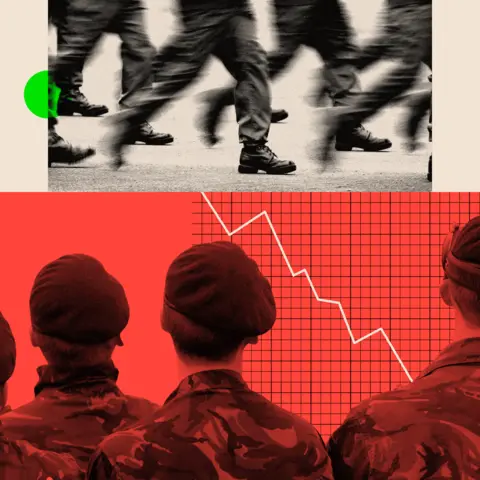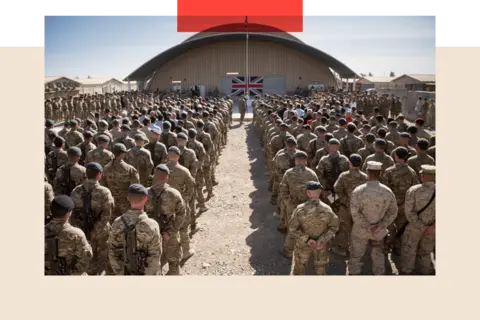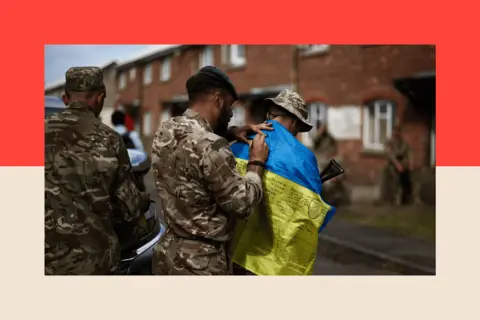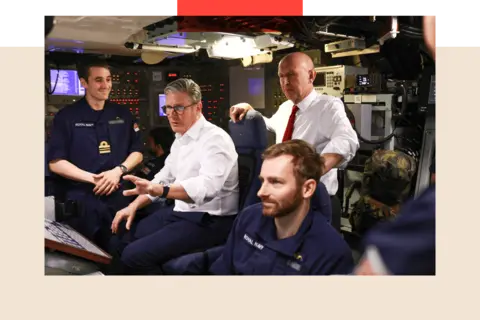The real problem facing Britain's shrinking military

 BBC
BBCOn a March day this year, a British nuclear-armed submarine quietly returned to its base on the west coast of Scotland after a record-breaking 204 days underwater. HMS Vanguard had 130 crew members on board. They had spent nearly seven months without fresh air or daylight, and with little communication.
Patrols of the UK's nuclear-armed submarines are supposed to last no longer than three months. But the last eight patrols have all exceeded five months, as the navy's ageing fleet of submarines requires ever more time in maintenance. It means the submariners on board are spending longer and longer underwater.
A submariner who was on board one of those long patrols described to me a worrying situation in which the crew ran low on food and medicines. Towards the end of the patrol he described how hungry crew members rummaged for tins of food in hidden compartments inside the submarine. He said they even had to make bread out of custard powder, because they'd run out of flour.
The navy has long found it difficult to recruit sailors into its Submarine Service, often known as the "Silent Service".
But the case of the 204-day patrol by HMS Vanguard raises a wider issue.
 Crown copyright
Crown copyrightVirtually everyone agrees that Britain's armed forces are depleted. Troop numbers are down, morale is weak, and some ageing equipment is in a poor state. And all this comes at a time of greater geopolitical uncertainty, as the threat from Russia looms large across Europe.
Within the next few months, the government will publish its long-awaited Strategic Defence Review - a consultation launched by Sir Keir Starmer shortly after he arrived in Downing Street last summer, designed to identify threats to Britain and recommend how the armed forces can meet them. But there are already doubts over how much it can realistically achieve.
So, as the world becomes more dangerous, what can the government do to reverse the decline - and restore the UK to military readiness?
Dwindling troop numbers
Politicians from all sides, along with military chiefs, admit Britain's armed forces have been "hollowed out". It's true for the Royal Navy and the RAF - and perhaps most acutely, in the British army.
In 2010 the regular Army was nearly 110,000 strong. Now, it is struggling to meet its target of 73,000 soldiers - not enough to fill Cardiff's Principality Stadium.
Earlier this year defence minister and former Royal Marine, Al Carns, told a conference at the Royal United Services Institute, a think tank, that the entire British Army could be "expended" within six to 12 months if it fought a war on a similar scale to the Ukraine conflict.
Last summer the head of the army, General Sir Roly Walker, said the Army needed to be ready to fight a war by 2027 - an admission it isn't ready to fight one in its current state. He said the Army needs to leverage technology, such as drones, new software, and artificial intelligence.
 Getty Images Europe
Getty Images EuropeBut Justin Crump, an Army Reserve Officer who heads the risk and intelligence company Sibylline, argues that boosts to technology won't make up for the lack of military hardware. "We have big gaps and they're not going to get filled overnight," he says.
The government is also promising to streamline the bureaucratic process of ordering new kit - trying to learn the painful lessons of past mistakes. By the time they eventually arrive, the delivery of hundreds of new Ajax armoured vehicles will have taken more than a decade.
Weaknesses in its Nato commitments
Speak to any government minister about security, they'll no doubt talk about Nato. It's the cornerstone of the UK's security, the government says, and one that has only become more important since Russia's invasion of Ukraine.
According to its Nato commitments, the UK is supposed to be able to field tens of thousands of troops at short notice to defend any Nato territory – with a war-fighting division made up of tanks, artillery, and heavy armour.
But a former senior General told the BBC that in a real war it would run out of ammunition, spares and supplies within weeks or even days. Nor does Britain have much in terms of ground-based air defences – not enough to protect key military bases in the UK, yet alone its towns and cities.
The weaknesses in Britain's contribution to Nato became starkly apparent in February this year, when a group of British MPs visited a Nato military site in Tapa, Estonia, where British soldiers are deployed (alongside Danish and French troops). The point of the base is to deter or slow down an invasion from Russia - which is just 80 miles away over a land border.
Mike Martin, a Liberal Democrat MP and former British Army Officer, said the Estonia visit was like going back in time, seeing the same equipment as when he first joined the Army as a reservist in 2004: ageing Challenger 2 tanks and Warrior armoured vehicles. What one former General described to me as "legacy kit from the 1980's" - old and dwindling in numbers.
About 1,000 British troops are stationed at the site. At the time of the MPs' visit they were armed with some drones - though not many. Nor did they have much in the way of systems to block or jam enemy drones, either. They also have a handful of long-range artillery guns - important for land warfare. The British Army currently has a total of just 14. Even tiny Estonia has double that number.
Defence sources say that since the MPs' visit, the Army has now begun to test some of the new technology it wants to introduce. They say it "will help soldiers see further, and strike faster".
 AFP/Getty Images
AFP/Getty ImagesTalk of thousands of British troops being sent to Ukraine for a lengthy deployment, if there were to be a ceasefire in its war with Russia, would present another huge challenge.
In the recent past the British army has just about managed to sustain a prolonged military campaign. But in Afghanistan, between 2006 and 2014, it was only fighting lightly armed Taliban insurgents. Even then it was stretched - with nine thousand troops being constantly rotated every six months.
Crump says "Afghanistan was painful enough, and we had 20,000 more people". While he says providing a reassurance force for Ukraine "might be doable – it would rapidly wear us down".
Questions over the price tag
The government says it is addressing these challenges with its Strategic Defence Review. John Healey, the Defence Secretary, claims it will lead to the "biggest shake up of UK defence for over 50 years".
But past reviews have rarely lived up to expectation – not least because the money available rarely matches ambitions. Most reviews are quickly overtaken by events. Harold Wilson's defence review of 1966 was overtaken just three years later by a crisis in Northern Ireland; whilst Tony Blair's review of 1998 came just three years before 9/11.
Indeed, when work on this review began, the US - under President Joe Biden - was still the UK's closest and most reliable military partner. Now that's less clear.
 Getty Images Europe
Getty Images EuropeThere are also questions over the price tag. The review's terms of reference assumes that defence spending will be capped at 2.5% of the UK's national income, or Gross Domestic Product (GDP). But few in defence believe that'll be enough.
One of the independent experts leading the review, General Sir Richard Barrons, has already said the UK should be spending at least 3% of GDP on its armed forces. Meanwhile, Nato's Secretary General, Mark Rutte, is pressing allies to increase defence spending to "north of 3%". President Donald Trump has gone even higher, urging Nato countries to spend 5%.
The government's "ambition" is to boost spending to 3% at some time in the next parliament - which will have the added bonus of boosting growth, ministers say. Just last week Sir Keir said that extra investment will create a "defence dividend" for jobs and prosperity.
Others think the review is too narrow in focus. A former military chief told the BBC that a review should first identify threats to the UK, and then work out how to shape the Armed Forces. It was "bonkers", they added, to conduct a defence review without it being "nested" in a broader cross-government security review.
 Reuters
ReutersAn MoD spokesperson said that boosts to defence spending "will make Britain stronger and safer in an insecure world and will help us build a modern and resilient Armed Forces, with cutting-edge capabilities".
The defence review, they added, is "wide-ranging and working at pace, looking hard at the threats we face and all the capabilities we need to meet the challenges and opportunities of the 21st century".
Low morale and cases of harassment
Attempts to broaden the Army's appeal - including high-profile recruitment campaigns targeting the so-called "snowflake" generation - have not been enough to reverse the decline. Nor have a series of slick television adverts called "Belonging", which aim to highlight the camaraderie of life in the forces.
Last year, the UK's armed forces were losing 300 more full-time personnel each month than they'd been recruiting.
In a MoD survey last year nearly six in ten military personnel rated morale as low. Just four in 10 said they were satisfied with service life – the lowest since records began.
This government is trying to boost morale by improving military accommodation, plus last year's pay rise of 6% for armed forces personnel was the largest in two decades.
Part of the problem is a broader cultural one: fewer people have an emotional connection with the armed forces, Crump says. The average Briton is now more likely to know someone in jail than serving in the military, he adds.
Last year, the Army apologised to Kerry-Ann Knight, a black female soldier who fronted Army recruitment campaigns, after she described years of racist abuse and bullying that made her life while serving a "living hell".
High profile stories of bullying and sexual harassment within the military can't have helped - particularly for women and minorities.
The MoD has set a recruiting goal of 30% women by 2030, but they currently make up less than 12% of the regular armed forces - a figure which has hardly shifted in a decade.
 Getty Images Europe
Getty Images EuropeBritain is not alone in struggling to fill its ranks. It's a problem experienced by many western nations relying on volunteers. Some governments have now introduced some form of conscription. In March, Polish Prime Minister Donald Tusk announced a plan to make all Polish men undergo compulsory military training.
But there appears to be little appetite for conscription among the British public. A YouGov poll in September 2023 found that just 28% of the British public would support a one year military service. Younger people were particularly opposed.
The government wants to get people interested from a young age, by expanding cadet forces in secondary schools. The MoD is also trying to keep better records of those troops who have left, and who could be recalled in a crisis.
An MoD spokesperson said: "We are committed to fixing Armed Forces recruitment and have already given personnel the largest pay rise in decades, scrapped 100 outdated recruitment policies, and passed legislation through the Commons to introduce a new Armed Forces Commissioner to improve service life."
AI on the battlefield?
Whatever comes out of the defence review, there is no expectation that troop numbers will increase in the near future.
Analysts are, however, looking at radical solutions - including the use of Artificial Intelligence (AI) on the battlefield. The most obvious example is AI-enabled drones, which are already being used in Ukraine to identify targets on their own, to deadly effect. But some also envisage a future in which machines could collect data on adversaries.
A large land war in Europe is now focusing minds. Senior British military officers, as well as politicians, have repeatedly stated the UK 's armed forces must be ready to fight. But there still appears to be a temptation to use their power and influence much further away from home.
 Crown copyright
Crown copyrightLast month, HMS Prince of Wales - one of the Navy's two aircraft carriers – left Portsmouth on an eight-month voyage to the other side of the world. It's the biggest UK defence endeavour this year, involving nearly 4,000 personnel, along with the support of allies, sailing to the Pacific and back.
Healey says it will demonstrate the UK's ability to deploy a major military force around the world, while at the same time promoting British trade.
Emma Salisbury, a fellow at the Council on Geostrategy, a think tank, says the carrier's Pacific deployment holds a powerful symbolic importance. "It's a message not just of deterrence against Russia, but also against China," she says. "In the world as it is now, we can't look at things geographically. Everything is interconnected. It's linking together our alliances and partnerships on a global scale."
But the deployment also highlights the challenges of trying to do more with less. Britain can only afford to have an episodic appearance in the Indo-Pacific. And the Trump administration has warned UK and other European allies to focus on their own doorstep, rather than faraway adventures. The carrier deployment is another strain on finite resources.
Of course, ministers maintain that their soon-to-be published defence review really could reset the dial and restore the UK to military readiness. But so far no government has really been willing to tackle the greatest dilemma for UK defence: do less or spend a lot more.
BBC InDepth is the home on the website and app for the best analysis, with fresh perspectives that challenge assumptions and deep reporting on the biggest issues of the day. And we showcase thought-provoking content from across BBC Sounds and iPlayer too. You can send us your feedback on the InDepth section by clicking on the button below.
